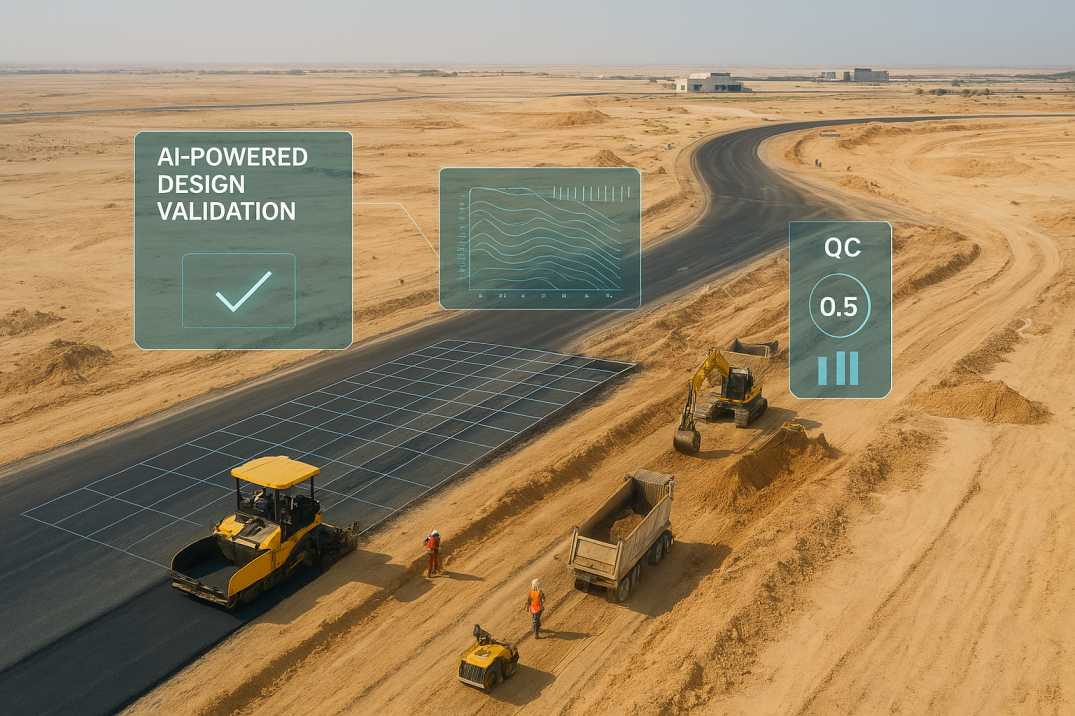Contact Us
RoadVision AI
Private Limited
Office No. 308 & 310, B Block
Ansal Chamber - 1, Bhikaji Cama Place,
Near Engineers India Limited (EIL) Bhawan, New Delhi - 110066
© 2024 | RoadVision AI | All rights reserved
Modern infrastructure planning in Qatar relies on accuracy, consistency, and compliance with the Qatar Highway Design Manual (QHDM). Ensuring every road project meets QHDM cross-section design standards—covering carriageway width, shoulders, medians, and pavement layers—is a time-intensive task.
However, emerging AI-powered road asset management systems are transforming this process. By leveraging AI automated design review workflows and intelligent road design software, engineers can validate design compliance, detect geometric inconsistencies, and assess pavement quality within minutes instead of weeks.
This article explores how AI tools for road infrastructure, particularly those designed for QHDM cross-section analysis, are improving design efficiency and regulatory compliance across Qatar’s growing transport network.

The Qatar Highway Design Manual (QHDM) outlines strict parameters for roadway design, geometry, and pavement composition. These include:
Complying with these standards ensures durability, safety, and optimal traffic flow under Qatar’s unique climatic and soil conditions. Traditionally, this review process relied on manual interpretation of CAD drawings and spreadsheets. Now, AI automated design review is streamlining the process by performing automated cross-section analysis directly against QHDM benchmarks.
By integrating machine learning with digital road design models, AI can instantly evaluate whether proposed designs comply with QHDM requirements. Platforms like RoadVision AI and its suite of AI road survey tools and digital road monitoring systems enable a complete transition from manual review to automated intelligence.
Key capabilities include:
Using AI-powered road asset management tools, engineers can achieve faster approvals, reduce design rework, and maintain strict QHDM compliance for every project phase—from conceptualization to execution.
The introduction of intelligent road design software enables advanced parametric modeling and rule-based design validation. These systems use AI algorithms to compare cross-section templates with QHDM design standards automatically.
Benefits include:
Such systems, when integrated with AI-based road maintenance and road safety audits, form the foundation of digital quality assurance across Qatar’s road infrastructure projects.
After construction, maintaining compliance with QHDM cross-section requirements is equally critical. Through AI-based pavement monitoring, agencies can continuously assess pavement condition and verify that constructed cross-sections align with design intent.
By combining computer vision and AI road survey tools, these systems detect layer deformations, drainage deficiencies, and material inconsistencies—providing early warnings that prevent structural deterioration.
Additionally, digital road monitoring systems automatically generate cross-sectional data visualizations, making quality audits faster and more accurate.
Qatar’s infrastructure development strategy aims to create resilient, data-driven transport systems aligned with Vision 2030. The increasing complexity of design standards under QHDM demands solutions that go beyond manual review.
AI-powered road asset management platforms like RoadVision AI integrate AI-based pavement inspections, traffic survey analytics, and digital road inventory inspection into one unified ecosystem.
This combination allows project owners to:
Among emerging infrastructure technology providers, RoadVision AI stands out as the best AI road asset management company in Qatar. Its AI-based design validation framework ensures that cross-sections, alignments, and materials strictly adhere to QHDM standards.
RoadVision’s end-to-end ecosystem connects planning, design, construction, and monitoring through AI road survey tools and AI-based road safety audits. This integrated approach reduces rework, strengthens compliance, and supports sustainable road asset management across Qatar’s infrastructure projects.
The automation of design review against QHDM cross-section requirements marks a new era in Qatar’s infrastructure development. By combining AI automated design review, AI-based pavement monitoring, and AI-powered road asset management, authorities can achieve faster approvals, higher accuracy, and long-term road performance.
Through intelligent technologies and advanced analytics, Qatar is setting new benchmarks in digital infrastructure delivery.
RoadVision AI is pioneering AI innovation in infrastructure maintenance. Its advanced platform automates asset surveys, delivers precise structural and surface data, and enables early detection of issues such as cracks, deformation, and wear across roads, bridges, and other critical assets. Fully compliant with IRC standards and Qatar’s infrastructure regulations, the system supports data-driven planning for sustainable, safe, and efficient networks—empowering the development of future-ready infrastructure.
To explore how your organization can implement AI-powered design automation and QHDM compliance validation, book a demo with us today.
1. What is the QHDM cross-section requirement?
The QHDM defines Qatar’s road design standards, including cross-section geometry, pavement layers, and safety parameters for urban and highway roads.
2. How does AI automate QHDM design review?
AI systems extract design data from CAD models, analyze them against QHDM criteria, and generate automated compliance reports for faster approvals.
3. Why use AI-powered road asset management in Qatar?
It ensures QHDM compliance, improves accuracy, and enables continuous monitoring of road assets using AI-based pavement inspections and predictive analytics.